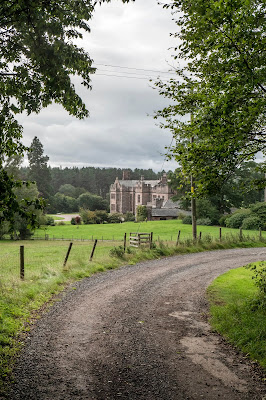Maybe not the usual way for getting up to the Lakes but it was a Bank Holiday Saturday and, by the time I had reached Settle, I was sick and tired of the A65. Farm vehicles were the main culprits with one holding up the traffic from just outside of Skipton until it turned off a mile or so before Hellifield. The cars behind weren't prepared to overtake so an ever increasing queue of frustrated drivers formed.
I had some shopping to do so I turned off at Settle and then followed the Horton in Ribblesdale road as far as the Ribblehead Viaduct. This was the only busy place of my drive. No matter how much roadside parking spaces they develop, there is still not enough especially at weekends and, with this being a Bank Holiday weekend, boy was it busy.
I took to the Hawes road and, after a couple of miles, I headed down in to Dentdale and past the Dent Head Viaduct. No matter how many times I go on this road, I have to stop and take a photo of the viaduct. The viaduct sits perfectly in the wooded v-shaped valley and is looked down upon by rough and uncompromising wild moorland with high fells beyond.
I then followed the Old Coal Road past Dent Station to Garsdale Head and then on to Kirkby Stephen via Mallerstang. The Old Coal Road's name comes from back in the mining days when the area had extensive coal
workings which lay on the moorland either side of the road. These coal pits were worked by local
people, initially to produce domestic fuel, but by the 18th century,
the poor quality coal was also being used in lime kilns. Commercial coal
mining went on in Garsdale until the 1870s when the Settle-Carlisle
railway started bringing in cheaper, higher quality coal from the
Lancashire and West Yorkshire coalfields.
The highlight of Mallerstang is the ruins of Pendragon Castle which is reputed to have been founded by Uther Pendragon, the father of King
Arthur. According to legend, Uther Pendragon and a hundred of his men
were killed here when the Saxon invaders poisoned their well. There are
also claims that the Romans built at least a temporary fort here, along
the road between their forts at Brough and Bainbridge but, apart from
legend and supposition, there is no real evidence that there was any
building here before the Normans built their castle in the 12th Century.
It was built next to the River Eden in the late 12th century, probably by Hugh de Morville and, like the nearby castles of Appleby and Brough,
Pendragon came into the possession of the Clifford family. It was
abandoned after a raiding Scottish army set fire to the castle in 1341,
but was rebuilt in 1360. It was left in ruins by another fire in 1541,
but was restored in the mid 17th century by Lady Anne Clifford. The castle gradually fell back into ruin after her death and now remains a romantic ruin set in stunning scenery.
Lady Anne Clifford's Way is a long distance footpath which takes in five of the Clifford families ruinous castles: these include Skipton, Pendragon, Appleby, Brough and Brougham Castles. At the age of 60, she spent the next 26 years of her life restoring the mostly ruinous family castles to their former glory. Some woman eh?
After Kirkby Stephen it was then on to the A66 (which fortunately wasn't too busy), passing Appleby, Brough and Brougham Castles and then through Penrith before arriving in the Lakes. It may have been a few miles longer than my normal drive but it was much more enjoyable and certainly more interesting to read about!
 |
| Dent Head |
 |
| Dent Head Viaduct |
 |
| Above Dentdale |
 |
| Wild Boar Fell |
 |
| Mallerstang |
 |
| The Old Coal Road |
 |
| Wild Boar Fell |
 |
| Rose Bay Willow Herb |
 |
| Pendragon Castle, Mallerstang |
 |
Pendragon Castle, Mallerstang
|
 |
Pendragon Castle, Mallerstang
|
 |
| Mallerstang |



































































